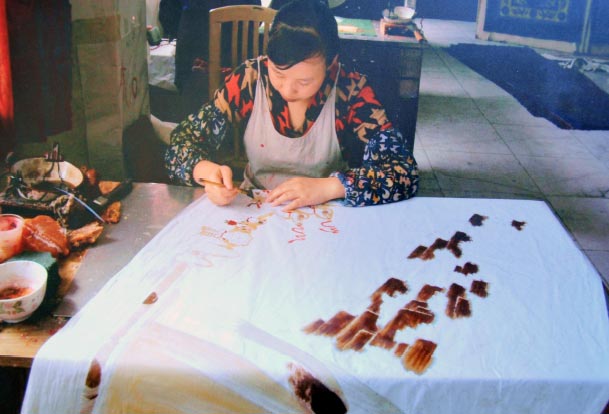 Batik was quite popular in the Song dynasty in China but declined in later years. Nowadays, it has mainly remained in the Miao regions in Guizhou Province.
Batik was quite popular in the Song dynasty in China but declined in later years. Nowadays, it has mainly remained in the Miao regions in Guizhou Province.
The production process is comprised of using beeswax and paraffin wax, drawing the patterns with a melted wax liquid and a hand-tailored wax knife or sharpened bamboo stick on the cloth, and then dipping it into the indigo blue dye solution. The part of the cloth without the wax becomes dyed blue.
Due to the quick solidification of the liquid wax in the painting process, the wax knife cannot stay on the cloth for very long, which requires the painter to work very swiftly and skillfully. An accomplished painter usually draws free form and it takes a few days to finish drawing a complex and attractive scarf.
Different from bandhnu, a piece of painted batik cloth will be taken out of the dyeing container to be aired and cured for several hours in every 30 minutes[??]. Soybean slurry and local rice wines are applied to enhance the adhesion of the pigment to the cloth. The longer the cloth is soaked, the darker the colour. Sometimes, after being dyed, red and yellow colour will by added to augment the blue and white colours with a simple and handsome elegance. The most commonly used material for batiks is a locally woven soil-grain cloth, which has a concave-convex feel and is thick and durable. It contains the required unique texture and visual effect.
The cloth is then put into boiling water to remove the wax and enable the blue and white design to appear. Due to the wax cracks that naturally occur after the wax solidifies and in the process of soaking and dying, the patterns will be full of natural cracks, which in the end form a type of ever-changing grainy delineation like that which occurs in broken ice. Even for the same individual artisan, the printed patterns are always different. People call it the soul of batik.
The bronze drum (timbal) is the local Miao ethnic minority’s main sacrificial utensil and is also a symbol of power and honor. Created by rubbings of the decorative patterns imprinted on the bronze timbals, these batik patterns are now often used as bedcovers at funerals as a respect for the deceased elderly. The timbal patterns are also used on some children’s clothing, bestowing a blessing on the children to become a respected person when they are grown up.
When (and even before) new babies are born, mothers prepare various batik dresses for the newborn. Also, relatives and friends often send undergarments with the imprints of tiger eyes as an auspicious blessing. Some mothers sew several undergarments together, believing it will bring children more protection. Before a wedding, mothers hand make and prepare the bedding trousseau for their daughter in batiks, sewing blessings for the new couple for a lifetime of happiness into the fabric. The girl will do her own wax painting and prepare her own beloved dowry.